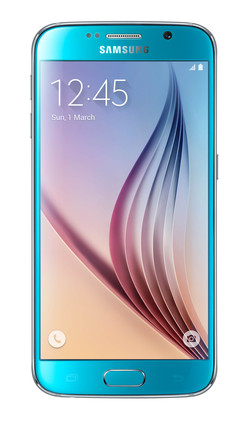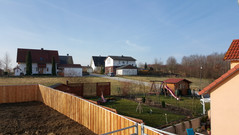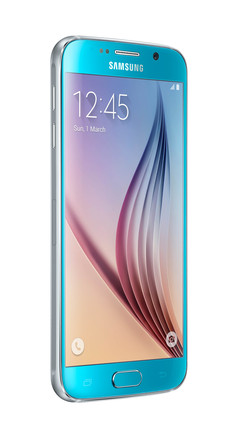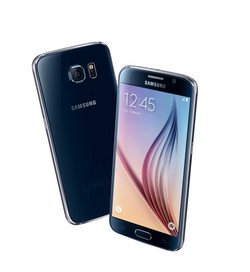Samsung Galaxy S6 First Impressions
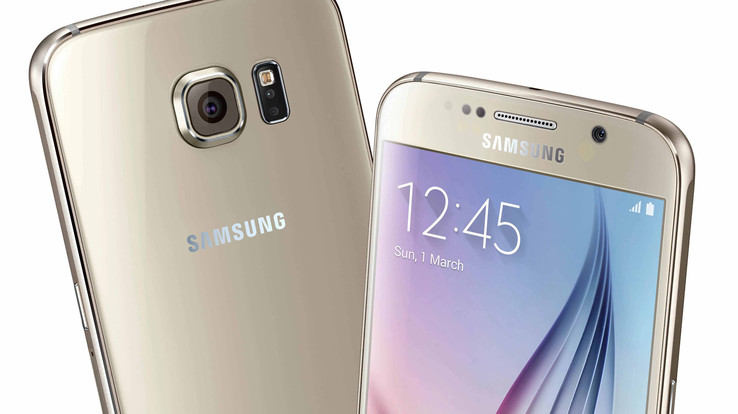
For the original German preview, see here.
Every year, Samsung wants to win the battle for the best smartphone with its flagship device from the S-series. At least temporarily, and we are now looking at the sixth generation of the bestseller. The Galaxy S6 once again follows the trend "bigger, faster, better," even though this does not apply for the display size this time. It is actually identical to the predecessor S5 (here in review) with 5.1-inches, but Samsung increased the resolution to 2560x1440 pixels. There is a performance increase as well thanks to Samsung's own octa-core processor. Potential buyers can also look forward to modern communication modules. Still: We expected all of this. The really new feature is the lack of a polycarbonate chassis; Samsung now uses aluminum and glass instead. We already know this trend from the A-series and there are certainly many users that were waiting for this change. Whether the abandonment of the replaceable battery and especially the microSD slot, which means you cannot expand the memory, will be appreciated, is doubtful. We think it is certainly a step in the wrong direction – just like the downgrade from USB 3.0 to USB 2.0. However, you get 3 GB memory instead of just the 2 GB from the predecessor.
So let's have a quick look at the new flagship device from the South Koreans, which already has to compete against a sibling right at the launch for the first time. The S6 Edge has also arrived in our editorial office and has to face the first tests right now.
First Impressions
This is how a high-end smartphone should feel like. Almost perfectly assembled aluminum and scratch-proof Corning Gorilla 4 glass result in a very sophisticated haptic feeling. The Galaxy S6 is also pretty light (138 grams) and thin (6.8 millimeters), despite the 5.1-inch display. That the main camera is slightly protruding is not a big deal in our opinion, the hardware just needs some room. That the transition from glass to aluminum at the long sides of the chassis leaves a slightly scratchy feeling when you touch it with the fingers is forgiven as well. All in all, Samsung created a top-notch chassis that even resists strong pressure and twisting without any problems.
We also liked the first impression of the hardware buttons with their defined pressure point. They are also not wobbling around and do not create annoying noises. Completely flat at the right side is the SIM-card slot, which only works with nano-SIMs. Samsung still uses a physical home button. The single speaker, however, which is located in the lower part of the chassis, cannot really convince us. As is typical for a smartphone, you do not get any bass at all, but medium and high tones could be clearer as well. It is at least loud enough and there are no distortions.
Cameras & Multimedia
A big topic ahead of the S6 presentation was the camera equipment. Samsung once again wants to set new records for the picture quality. The South Korean manufacturer equips the device with a 16 MP main camera, which is nothing special for a high-end smartphone. However, an aperture of f/1.9 is special. This means we can hope for sharp and sufficiently exposed pictures in low-light situations. The optical image stabilizer should also help to improve the video quality. At the front is a 5 MP sensor. We have seen for a while now that Samsung is following the Selfie trend.
Our first pictures already show that the Galaxy S6 should be one of the best camera smartphones. The sharpness is very high, but it does not look unnatural. Bright-dark contrasts are traced well, and sunlight from the side is no problem for the sensor, either.
Display
Samsung's magical solution for the display is nowadays often called Super-AMOLED. This technology is even used for lower mainstream smartphones nowadays – at least for Samsung devices. There is no alternative for its high-end device. Super-AMOLED convinces with extreme contrasts, a pure black and perfect viewing angles. You immediately understand why Samsung favors the OLED technology if you ever used a tablet from the Galaxy Tab S-series next to an Apple iPad. Even the first manufacturer's logo shows the differences. It is a matter of honor for Samsung that the sixth generation of its flagship device also features the highest display resolution so far. 2560x1440 pixels results in a pixel density of 577 ppi. You should visit a doctor if you can still see blurry elements or aliasing.
We obviously evaluated the display for this preview article as well. The results once again show that the South Koreans understand their job. The average result of the maximum brightness does not sound very good with 345 cd/m², but it is easily sufficient for bright rooms – especially since there is a lot of headroom when you use the S6 outdoors. According to Samsung, the panel can reach up to 600 cd/m² with the activated light sensor. A first test shows that this value is realistic. This also applies for the deep black and the (theoretical) infinite contrast. Only small drawback: The brightness distribution is not on a reference level with 89%. However, the S6 can convince with great colors. Our in-depth review will certainly support this. The conclusion: Display – great!
| |||||||||||||||||||||||||
Brightness Distribution: 89 %
Center on Battery: 335 cd/m²
Contrast: ∞:1 (Black: 0 cd/m²)
ΔE ColorChecker Calman: 2.51 | ∀{0.5-29.43 Ø4.77}
ΔE Greyscale Calman: 2.59 | ∀{0.09-98 Ø5}
Gamma: 2.43
CCT: 6424 K
| Samsung Galaxy S6 Mali-T760 MP8, Exynos 7420, 32 GB UFS 2.0 Flash | Apple iPhone 6 Plus PowerVR GX6450, A8, 64 GB eMMC Flash | LG G3 Adreno 330, 801 MSM8974AC, 16 GB eMMC Flash | OnePlus One Adreno 330, 801 MSM8974AC, 64 GB eMMC Flash | Samsung Galaxy S5 Adreno 330, 801 MSM8974AC, 16 GB eMMC Flash | Sony Xperia Z3 Adreno 330, 801 MSM8974AC, 16 GB eMMC Flash | |
|---|---|---|---|---|---|---|
| Screen | 2% | -41% | -55% | -37% | -64% | |
| Brightness middle (cd/m²) | 335 | 519 55% | 417 24% | 423 26% | 358 7% | 702 110% |
| Brightness (cd/m²) | 345 | 496 44% | 395 14% | 408 18% | 364 6% | 671 94% |
| Brightness Distribution (%) | 89 | 90 1% | 89 0% | 83 -7% | 82 -8% | 90 1% |
| Black Level * (cd/m²) | 0.62 | 0.96 | 0.54 | 0.72 | ||
| Colorchecker dE 2000 * | 2.51 | 3.67 -46% | 5.67 -126% | 5.56 -122% | 5.28 -110% | 8.92 -255% |
| Greyscale dE 2000 * | 2.59 | 3.78 -46% | 5.66 -119% | 7.55 -192% | 4.65 -80% | 9.59 -270% |
| Gamma | 2.43 91% | 2.42 91% | 2.53 87% | 2.33 94% | 2.48 89% | 2.75 80% |
| CCT | 6424 101% | 7327 89% | 7741 84% | 7624 85% | 7690 85% | 9408 69% |
| Contrast (:1) | 837 | 434 | 783 | 975 | ||
| Color Space (Percent of AdobeRGB 1998) (%) | 59 |
* ... smaller is better
Performance
It is clear that we only expect the best of the best from a brand-new flagship smartphone. Samsung does not disappoint when we look at the specs. Samsung's own Exynos 7420 Octa has eight cores; four are based on the Cortex A53 and four on the Cortex A57 architecture. The latter run with up to 2.1 GHz and are supposed to ensure high computing performance if necessary. The A53 cores are slower with 1.5 GHz; they are supposed to combine decent performance with low power consumption. The 14 nm manufacturing process will certainly improve the efficiency as well. The Exynos 7 Octa is the first chip of its kind that is manufactured in this process. 64-bit code is supported by the SoC as well, which already results in some advantages in individual tests with Android Lollipop right now (AnTuTu v5 64-bit, for example). The processor is also accompanied by a brand-new GPU. The ARM Mali-T760 in the S6 has eight clusters, which are clocked with 700 up to 772 MHz. The high-end graphics chip also supports Open CL 1.1 and DirectX 11 besides OpenGL ES 3.1.
The first benchmarks can live up to the expectations from the spec sheet: The Samsung Galaxy S6 can take the first spot in almost all benchmarks. Only the HTC One M9, which is brand-new as well, and the Apple iPhone 6, even though it can only win in two disciplines, are competitive. The flagship device from Apple only manages a significant advantage in Geekbench 3 and SunSpider 1.0, but it is beaten by the S6 in all the other tests. The Samsung flagship is currently fighting for the performance crown in our benchmarks. The biggest competitor is the HTC One M9, and both top models are neck and neck in the CPU and GPU tests. However, we can already see a big advantage for the Galaxy in respect of the storage and browser performance, which means the S6 is certainly a serious contender for the performance throne after this preview.
| Geekbench 3 | |
| 32 Bit Single-Core Score (sort by value) | |
| Samsung Galaxy S6 | |
| Apple iPhone 6 | |
| LG G3 | |
| OnePlus One | |
| Samsung Galaxy S5 | |
| Sony Xperia Z3 | |
| HTC One M9 | |
| 32 Bit Multi-Core Score (sort by value) | |
| Samsung Galaxy S6 | |
| Apple iPhone 6 | |
| LG G3 | |
| OnePlus One | |
| Samsung Galaxy S5 | |
| Sony Xperia Z3 | |
| HTC One M9 | |
| AnTuTu v5 - Total Score (sort by value) | |
| Samsung Galaxy S6 | |
| Apple iPhone 6 | |
| LG G3 | |
| OnePlus One | |
| Sony Xperia Z3 | |
| HTC One M9 | |
| 3DMark | |
| 1280x720 offscreen Ice Storm Unlimited Score (sort by value) | |
| Samsung Galaxy S6 | |
| Apple iPhone 6 | |
| LG G3 | |
| OnePlus One | |
| Samsung Galaxy S5 | |
| Sony Xperia Z3 | |
| HTC One M9 | |
| 1280x720 offscreen Ice Storm Unlimited Graphics Score (sort by value) | |
| Samsung Galaxy S6 | |
| Apple iPhone 6 | |
| LG G3 | |
| OnePlus One | |
| Samsung Galaxy S5 | |
| Sony Xperia Z3 | |
| HTC One M9 | |
| 1280x720 offscreen Ice Storm Unlimited Physics (sort by value) | |
| Samsung Galaxy S6 | |
| Apple iPhone 6 | |
| LG G3 | |
| OnePlus One | |
| Samsung Galaxy S5 | |
| Sony Xperia Z3 | |
| HTC One M9 | |
| GFXBench 3.0 | |
| on screen Manhattan Onscreen OGL (sort by value) | |
| Samsung Galaxy S6 | |
| Apple iPhone 6 | |
| LG G3 | |
| OnePlus One | |
| Samsung Galaxy S5 | |
| Sony Xperia Z3 | |
| HTC One M9 | |
| 1920x1080 1080p Manhattan Offscreen (sort by value) | |
| Samsung Galaxy S6 | |
| Apple iPhone 6 | |
| LG G3 | |
| OnePlus One | |
| Samsung Galaxy S5 | |
| Sony Xperia Z3 | |
| HTC One M9 | |
| AndroBench 3-5 | |
| Random Read 4KB (sort by value) | |
| Samsung Galaxy S6 | |
| LG G3 | |
| OnePlus One | |
| Samsung Galaxy S5 | |
| Sony Xperia Z3 | |
| HTC One M9 | |
| Random Write 4KB (sort by value) | |
| Samsung Galaxy S6 | |
| LG G3 | |
| OnePlus One | |
| Samsung Galaxy S5 | |
| Sony Xperia Z3 | |
| HTC One M9 | |
| Sequential Read 256KB (sort by value) | |
| Samsung Galaxy S6 | |
| LG G3 | |
| OnePlus One | |
| Samsung Galaxy S5 | |
| Sony Xperia Z3 | |
| HTC One M9 | |
| Sequential Write 256KB (sort by value) | |
| Samsung Galaxy S6 | |
| LG G3 | |
| OnePlus One | |
| Samsung Galaxy S5 | |
| Sony Xperia Z3 | |
| HTC One M9 | |
| Octane V2 - Total Score (sort by value) | |
| Samsung Galaxy S6 | |
| Apple iPhone 6 | |
| LG G3 | |
| LG G3 | |
| Samsung Galaxy S5 | |
| Sony Xperia Z3 | |
| HTC One M9 | |
| Sunspider - 1.0 Total Score (sort by value) | |
| Samsung Galaxy S6 | |
| Apple iPhone 6 | |
| LG G3 | |
| LG G3 | |
| OnePlus One | |
| Samsung Galaxy S5 | |
| Sony Xperia Z3 | |
| HTC One M9 | |
| Browsermark - 2.1 (sort by value) | |
| Samsung Galaxy S6 | |
| Apple iPhone 6 | |
| LG G3 | |
| LG G3 | |
| OnePlus One | |
| HTC One M9 | |
| WebXPRT 2013 - Overall (sort by value) | |
| Samsung Galaxy S6 | |
| Apple iPhone 6 | |
| LG G3 | |
| LG G3 | |
| OnePlus One | |
| Samsung Galaxy S5 | |
| Sony Xperia Z3 | |
| HTC One M9 | |
* ... smaller is better
(+) The maximum temperature on the upper side is 35.6 °C / 96 F, compared to the average of 35.2 °C / 95 F, ranging from 21.9 to 247 °C for the class Smartphone.
(+) The bottom heats up to a maximum of 35.9 °C / 97 F, compared to the average of 34 °C / 93 F
(+) In idle usage, the average temperature for the upper side is 28.4 °C / 83 F, compared to the device average of 32.9 °C / 91 F.
Energy Management & Battery Runtime
Samsung also put some thought into the battery. It is unfortunate that it cannot be replaced anymore because of the aluminum chassis, but the capacity is pretty generous with 2550 mAh. The Samsung Galaxy S6 also supports wireless charging and – probably more important for many users – Fast Charge. A loading time of 10 minutes is supposed to be sufficient for a runtime of 4 hours. Speaking of battery runtime: The review period for the preview is too short to make any reliable statements. But the capacity of the battery in combination with the moderate power consumption should enable decent runtimes. The S6 is more frugal than the HTC One M9 in every scenario.
| Off / Standby | |
| Idle | |
| Load |
|
Key:
min: | |
Preliminary Verdict
The smartphone throne is shaking – massively. Samsung's Galaxy S6 is a big step forward in multiple sections. The first thing is the noble chassis made of metal and glass, which has an almost perfect build quality and also convinces with the low weight and the compact dimensions. The South Koreans also equipped the smartphone with powerful components. Samsung's own 64-bit octa-core SoC combines the highest performance with moderate power consumption. The first tests already show that hardly any other high-end device can keep up with the S6. Even if they could, the S6 would be very hard to beat in the camera and display section. The main camera convinces with a high light intensity and great picture quality, and the Super-AMOLED display is also in a league of its own.
So, is the battle for the best smartphone already decided? No. Only our in-depth review will show whether the S6 deserves the early praise. We also think that the lack of a microSD slot is a clear step in the wrong direction, especially if you have a look at the pricing for the Galaxy S6. The smallest configuration with 32 GB storage comes with a hefty price tag of 700 Euros (~$756), and Samsung even charges 900 Euros (~$973) for the 128 GB version. We expect that the market prices will drop pretty quickly, but the S6 certainly won't be a bargain.




